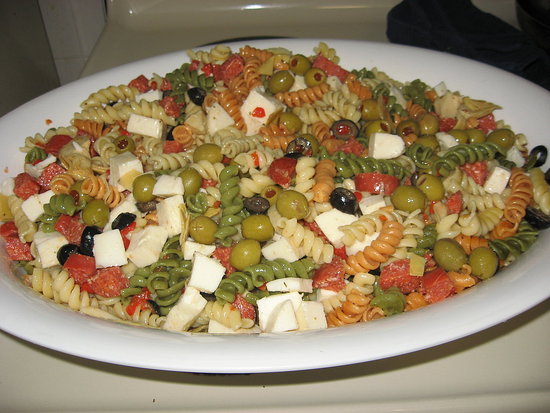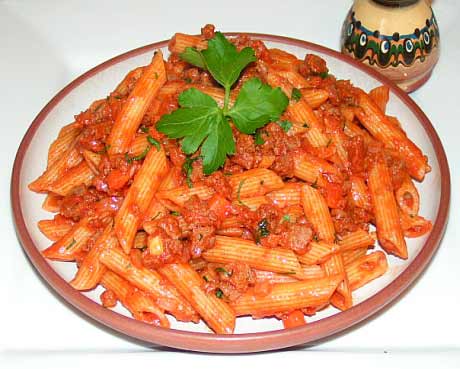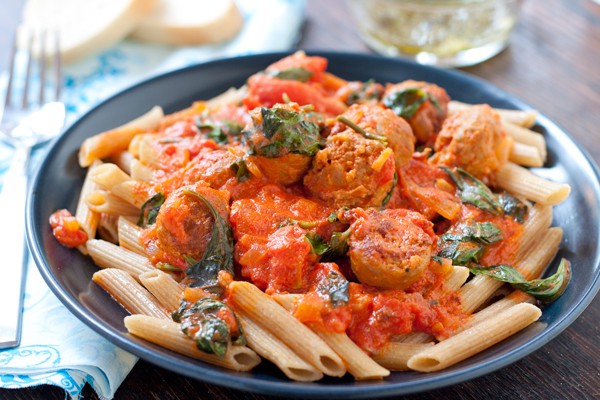Italian Recipes With Pasta Biography
Agnolotti is a type of pasta typical of the Piedmont region of Italy, made with small pieces of flattened pasta dough, folded over with a roast beef meat and vegetable stuffing. Agnolotti is the plural form of the Italian word agnolotto. The origin of the name may come from the name 'Angelot' from Montferrat, who is said to be the inventor of the recipe, or from the Latin word 'anellus', which refers to the ring-shaped material within the pasta, per 'The Word Origin Calndar 2009' compiled by Gregory McNamee and published by Accord Publishing.Although their primitive shape was circular, traditionally agnolotti are of a square shape, side of about 1 inch. However, they can also be of a rectangular smaller shape when they are called 'Agnolotti al Plin'. 'Plin' means a 'pinch' because you pinch with thumb and forefinger between each mound of filling to close and seal the little pasta packets. Agnolotti al Plin are almost always made by hand and are typical of Langhe and Monferrato.Typical dish of homemade Agnolotti Piemontesi alla moda di AstiAgnolotti are prepared by immersion in boiling water. Typically, they are dressed in a beef broth and a little melted butter or in a fresh sage and melted butter sauce, as a complex sauce would detract from the flavours in the agnolotti pockets. In both cases topped with Parmigiano Reggiano cheese but no cheese resides in the agnolotti. The dish is associated with Piedmont in Italy and is not to be confused with Parma's stuffed pasta pockets called 'Anolini'.Similar recipes with different stuffing without meat (e.g., ricotta cheese and spinach) are not properly agnolotti but ravioli.Bucatini, also known as perciatelli, is a thick spaghetti-like pasta with a hole running through the center. The name comes from Italian: buco, meaning "hole", while bucato means "pierced".Bucatini is common throughout Lazio, particularly Rome. It is a tubed pasta made of hard durum wheat flour and water. Its length is 25–30 cm (10–12 in) with a 3 mm (1/8 inch) diameter. The average cooking time is nine minutes. In Italian cuisine, it is served with buttery sauces, pancetta or guanciale, vegetables, cheese, eggs, and anchovies or sardines.Similarly, ziti are long hollow rods which are also smooth in texture and have square-cut edges; "cut ziti" are ziti cut into shorter tubes. There is also zitoni, which is a wider version of ziti.Cannelloni (Italian: large reeds) are a cylindrical type of pasta generally served baked with a filling and covered by a sauce. Some types of cannelloni need to be boiled beforehand, while for others, it is enough to use a more dilute sauce or filling. If one cannot find ready made cannelloni, rolling lasagne around a filling is an alternative. In Uruguay and Argentina, crepes are used instead of pasta.opular stuffings include spinach and ricotta or minced beef. The sauces typically used are tomato underneath and besciamella sauce to cover the top.t. Stephen's Day on December 26 is a traditional holiday in Catalonia. It is celebrated right after Christmas, with a feast including canelons. They are stuffed with ground meat from the escudella i carn d'olla, turkey or capon of the previous day (Christmas dinner).Besides Italy, cannelloni (Spanish: canelones) are very popular in Uruguay and Argentina due to the large Italian immigration to these countries. They are often eaten on Sundays by the whole family.Carbonara is an Italian pasta dish from Lazio, and more specifically Rome, based on eggs, cheese (Pecorino Romano or Parmigiano-Reggiano), bacon (guanciale or pancetta), and black pepper. Spaghetti is usually used as the pasta, however, fettuccine, rigatoni, linguine or bucatini can also be used. The dish was created in the middle of the 20th century.The pork is cooked in fat, which may be olive oil, lard, or less frequently butter. The hot pasta is combined with a mixture of raw eggs, cheese, and a fat (butter, olive oil, or cream) away from additional direct heat to avoid coagulating the egg, either in the pasta pot or in a serving dish. The eggs should create a creamy sauce, and not curdle. Guanciale is the most commonly used meat in Italy, but pancetta and local bacon are also used. Versions of this recipe may differ in how the egg is added: some people use the whole egg, while other people use only the yolk; intermediate versions with some whole eggs and some yolk are also possible.Cream is not common in Italian recipes but is often used elsewhere.Garlic is similarly found mostly outside Italy.Other variations on carbonara outside Italy may include peas, broccoli, mushrooms, or other vegetables. Many of these preparations have more sauce than the Italian versions. As with many other dishes, ersatz versions are made with commercial bottled sauces.with many recipes, the origins of the dish and its name are obscure.The dish forms part of a family of dishes involving pasta with bacon, cheese, and pepper, such as spaghetti alla gricia. Indeed, it is very similar to the southern Italian pasta cacio e uova, dressed with melted lard and mixed eggs and cheese.There are many theories for the origin of the name, which may be more recent than the dish itself. Since the name is derived from carbonaro (the Italian word for charcoal burner), some believe the dish was first made as a hearty meal for Italian charcoal workers. In parts of the United States the etymology gave rise to the term "coal miner's spaghetti". It has even been suggested that it was created as a tribute to the Carbonari ("charcoalmen"), a secret society prominent in the early, repressed stages of Italian unification It seems more likely that it is an urban dish from Rome, although it has nothing to do with the homonym restaurant in the Roman Campo de' Fiori square.Pasta alla Carbonara was included in Elizabeth David's Italian Food, an English-language cookbook published in Great Britain in 1954. However, the dish is not present in Ada Boni's 1927 classic La Cucina Romana and is unrecorded before the Second World War. It was first described after the war as a Roman dish, when many Italians were eating eggs and bacon supplied by troops from the United States.
Italian Recipes With Pasta Recipe Of Pasta In Urdu By Chef Zakir In Hindi Salad With White Sauce In Urdu In Indian Style In Red Sauce Photos
Italian Recipes With Pasta Recipe Of Pasta In Urdu By Chef Zakir In Hindi Salad With White Sauce In Urdu In Indian Style In Red Sauce Photos

Italian Recipes With Pasta Recipe Of Pasta In Urdu By Chef Zakir In Hindi Salad With White Sauce In Urdu In Indian Style In Red Sauce Photos
Italian Recipes With Pasta Recipe Of Pasta In Urdu By Chef Zakir In Hindi Salad With White Sauce In Urdu In Indian Style In Red Sauce Photos
Italian Recipes With Pasta Recipe Of Pasta In Urdu By Chef Zakir In Hindi Salad With White Sauce In Urdu In Indian Style In Red Sauce Photos
Italian Recipes With Pasta Recipe Of Pasta In Urdu By Chef Zakir In Hindi Salad With White Sauce In Urdu In Indian Style In Red Sauce Photos
Italian Recipes With Pasta Recipe Of Pasta In Urdu By Chef Zakir In Hindi Salad With White Sauce In Urdu In Indian Style In Red Sauce Photos
Italian Recipes With Pasta Recipe Of Pasta In Urdu By Chef Zakir In Hindi Salad With White Sauce In Urdu In Indian Style In Red Sauce Photos
Italian Recipes With Pasta Recipe Of Pasta In Urdu By Chef Zakir In Hindi Salad With White Sauce In Urdu In Indian Style In Red Sauce Photos
Italian Recipes With Pasta Recipe Of Pasta In Urdu By Chef Zakir In Hindi Salad With White Sauce In Urdu In Indian Style In Red Sauce Photos
Italian Recipes With Pasta Recipe Of Pasta In Urdu By Chef Zakir In Hindi Salad With White Sauce In Urdu In Indian Style In Red Sauce Photos










No comments:
Post a Comment